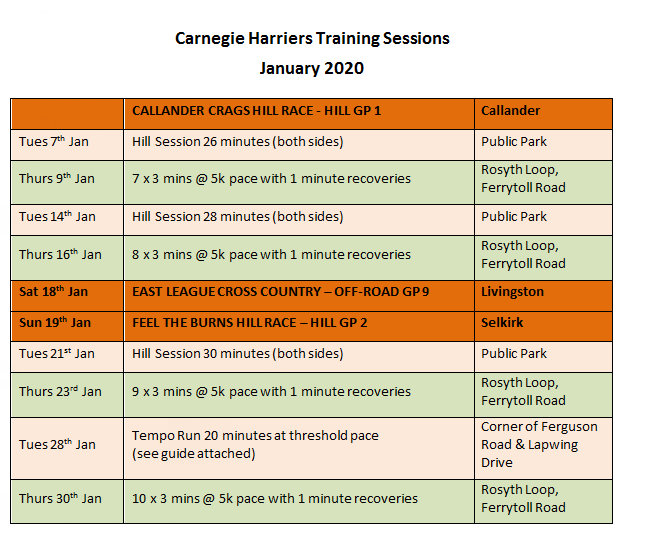Carnegie Harriers Training – January/February 2020
Welcome to January & February training.
At this time of year, we would be grateful if you could wear hi viz clothing to ensure your own safety and those of others using of our training venues.
On Tuesdays during January, we will be continuing our winter hill training in the Public Park, hill running being one of the most effective type of running for leg strengthening. At the end of the month, we will be doing Tempo sessions which will continue into February. A tempo session is slower than your 5k pace and you should feel “comfortably hard” (about 90% of MHR). A pace guide is attached at the end of this document. Please note that your pace will vary according to the length of the session.
On Thursdays in January, we will be begin a series of speed endurance sessions. These longer, faster paced intervals are beneficial not only for increasing anaerobic threshold levels, but they exercise all your leg muscles and can also help improve your flexibility. February will continue this theme but in a different format.
Please remember that the number of repetitions and the pace at which they are to be run are for guidance only. If you are tapering for, or recovering after a big race, or returning from illness/injury, or just had a really bad day, you can reduce the number of repetitions, or the pace, or both. You should aim to maintain the same pace throughout the session (unless the session states otherwise) but once your pace starts to drop off, you will no longer get any benefit from the session and we advise you stop.
Session Timings
Please meet at Pitreavie by 6.25pm to run as a group at 6.30pm to the training venue. If you are going directly to the venue, please aim to be there ready to start for 6.50pm. A dynamic warmup will take place prior to the start of the session. This aim of this is to warm up the muscles to their working temperature, stretching them and helping to improve their function. This also helps to reduce the risk of injury or imbalance. Remember also to cool down with a slow jog.
General Information
All our training is aimed at creating long-term physical changes in the body, referred to as adaptations. Key among this is the principle of overload, where the body is pushed beyond its normal rhythm. Overloading should be gradual and done over a training period to avoid a plateau or causing injury. Don’t confuse overload with overtraining. Overtraining syndrome is a condition that occurs when the body is pushed (through exercise) beyond its natural ability to recover. It is not to be confused with tiredness, which is to be expected whenever you are engaged in a comprehensive workout regime.
If you’re not currently racing, club sessions can all be adapted to suit you personally. Maybe you’re returning from injury or illness or after a more social pace; running with others can be a great motivator.
Training Feedback
The club’s training group comprises:
Lesley Reynolds (Lead)
Val Macaulay
Gordon Barrie
Neil Anderson
If you have any comments or feedback on training, please email [email protected] and they will be passed on to the group or speak to one of the training group at training.




